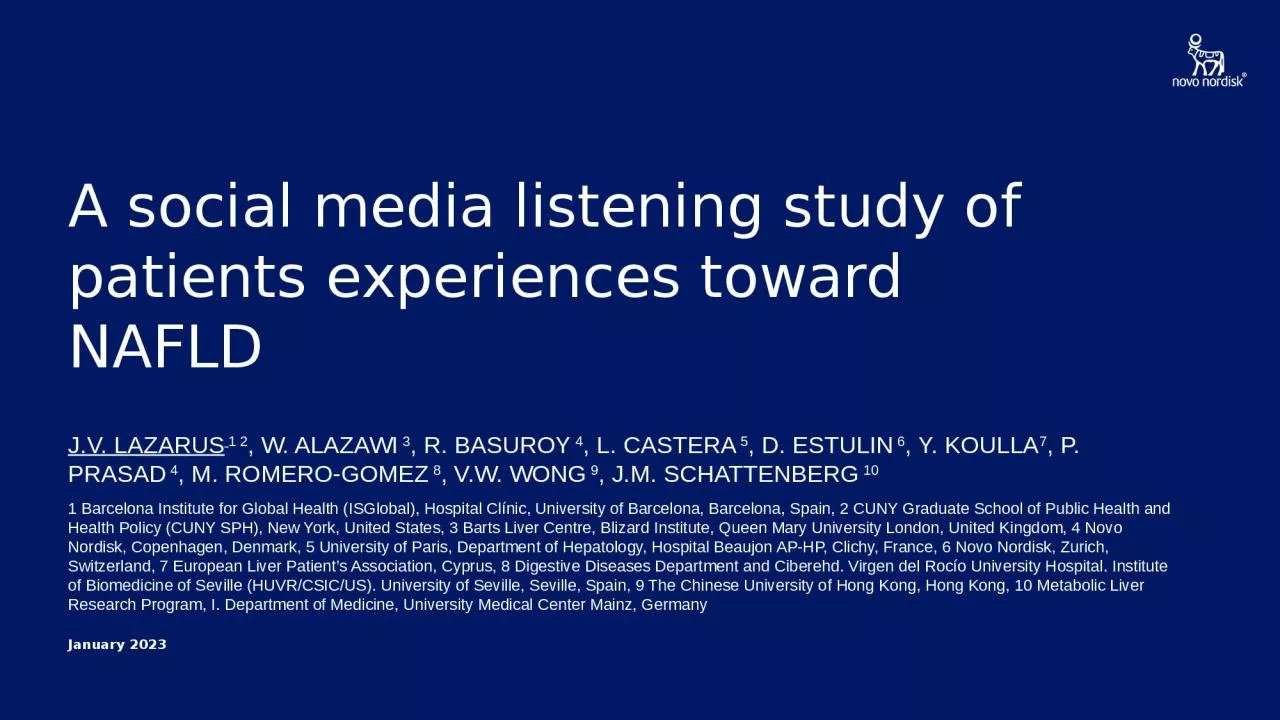

January 2023 JV LAZARUS 1 2 W ALAZAWI 3 R BASUROY 4 L CASTERA 5 D ESTULIN 6 Y KOULLA 7 P PRASAD 4 M ROMEROGOMEZ 8 VW WONG 9 JM SCHATTENBERG ID: 1048631
Download Presentation The PPT/PDF document "A social media listening study of patien..." is the property of its rightful owner. Permission is granted to download and print the materials on this web site for personal, non-commercial use only, and to display it on your personal computer provided you do not modify the materials and that you retain all copyright notices contained in the materials. By downloading content from our website, you accept the terms of this agreement.
1. A social media listening study of patients experiences toward NAFLDJanuary 2023J.V. LAZARUS 1 2, W. ALAZAWI 3, R. BASUROY 4, L. CASTERA 5, D. ESTULIN 6, Y. KOULLA7, P. PRASAD 4, M. ROMERO-GOMEZ 8, V.W. WONG 9, J.M. SCHATTENBERG 101 Barcelona Institute for Global Health (ISGlobal), Hospital Clínic, University of Barcelona, Barcelona, Spain, 2 CUNY Graduate School of Public Health and Health Policy (CUNY SPH), New York, United States, 3 Barts Liver Centre, Blizard Institute, Queen Mary University London, United Kingdom, 4 Novo Nordisk, Copenhagen, Denmark, 5 University of Paris, Department of Hepatology, Hospital Beaujon AP-HP, Clichy, France, 6 Novo Nordisk, Zurich, Switzerland, 7 European Liver Patient’s Association, Cyprus, 8 Digestive Diseases Department and Ciberehd. Virgen del Rocío University Hospital. Institute of Biomedicine of Seville (HUVR/CSIC/US). University of Seville, Seville, Spain, 9 The Chinese University of Hong Kong, Hong Kong, 10 Metabolic Liver Research Program, I. Department of Medicine, University Medical Center Mainz, Germany1
2. Introduction & AimSocial media is a powerful tool for patients to access healthcare information [1], connect with others, and share their experiences. Patients use social media to learn about new treatments and research, find support, and build communities [2]. Analyzing social media data can provide a more holistic view of patients' perceptions of their disease, which can be used to develop new research questions, to inform the development of new interventions, and ultimately to improve patient care. Social media listening is a mixed-method approach that identifies and assesses what is being posted and discussed about a topic on social media platforms, and data from these studies can provide valuable insights that may not be available through traditional research methods, such as surveys or interviews.The aim of this study is to gain patient-centric insights into NASH/NAFLD/MAFLD/Fatty Liver Disease/Steatotic Liver Disease patients, to have a holistic view of their patient journey, perception of treatment, quality of life impact or unmet needs, through social listening. 2[1] Ventola CL. Social media and health care professionals: benefits, risks, and best practices. P T. 2014;39(7):491-520.[2] Hamm MP, Chisholm A, Shulhan J, et al Social media use among patients and caregivers: a scoping review BMJ Open 2013;3:e002819. doi: 10.1136/bmjopen-2013-002819
3. Method3Data from blogs, forums, and social media platforms including Twitter, Facebook, and YouTube were collected using pre-defined keywords through licensed aggregator tools for 8 countries (Brazil, China, France, Germany, Japan, South Korea, Spain, UK), from Nov 2020 to Nov 2022. Manual and automated algorithms were used to clean up the dataset such as spam or posts from bots, and thematic analysis was used to summarise country-specific data.
4. Results4Patient journey stages: Patient journey posts (n=1479) were mainly about ongoing disease management (72%, 1061/1479), diagnosis & tests (50%, 734/1479), and causes & risk factors (36% 534/1479). Lifestyle management: Dietary changes (55%, 588/1061), exercise (39%, 417/1061) and weight loss methods (25%, 268/1061) were the most frequently discussed management techniques. Diagnostic tests: The key diagnostic tests mentioned were ultrasound (31%, 170/553), blood tests (24%, 130/553) and liver function tests (16%, 91/553). Perceived causes: Unhealthy diet (39%, 208/534), overweight/obesity (32%, 169/534) and harmful effects of medication (12%, 65/534) were perceived as the key causes leading to the condition.
5. Results5Quality of life impact: 12% (192/1600) discussed the impact of the disease on quality of life. Emotional journey: Emotional analysis (84%, 1338/1600) revealed patients were worried (20%, 266/1338) and frustrated (19%, 252/1338) about their condition, but they were also hopeful (14%, 186/1338) and determined (20%, 273/1338) to improve their health. Unmet needs: In 19% (311/1600) of conversations, an unmet need was highlighted, especially the need to access knowledgeable HCPs (16%, 51/311), driven by European countries. Other needs were better education (25%, 79/311) and management options (13%, 40/311), driven by Asian countries.
6. Results6Figure 1: Breakdown of key stakeholders and genderFigure 2: Patient age breakdown
7. Results7Figure 3: Key comorbidities mentioned by NAFLD patients onlineThe top 3 cardiovascular diseases mentioned were high cholesterol/hyperlipidemia (n=90), hypertension (n=65) and unspecified cardiovascular diseases (n=10).Within diabetes, type II diabetes (n = 68) followed by the unspecified type of diabetes (n=51) were the most mentioned.The top 3 digestive diseases mentioned were gallstones (n=33), gastritis (n=11) and IBS (n=10).
8. Results8Figure 3: Share of posts by key patient journey stages
9. Results9Figure 4: Key unmet needs according to NAFLD patients online
10. Conclusions10This social media listening study highlights the range of experiences of people living with NAFLD, including perceived challenges, coping strategies and unmet needs. Leveraging insights from social media can help us improve communication and NAFLD patient care through education and support.
11. 11